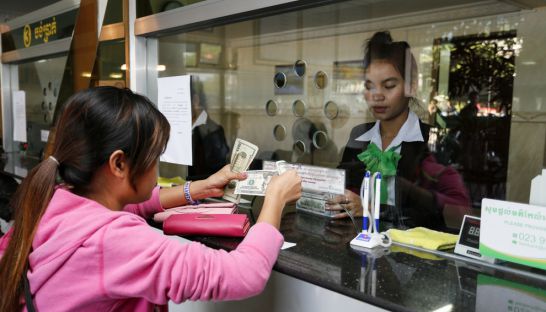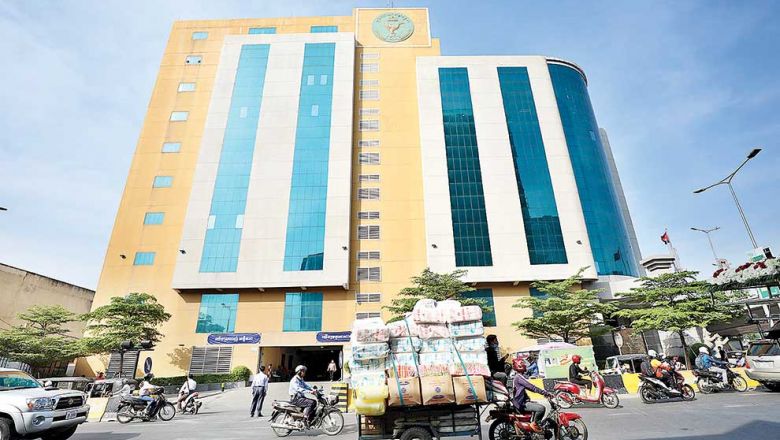Credit growth poses economic risk, IMF warns
Credit growth poses economic risk, IMF warns
Rapid credit growth – increasingly financed by bank flows from abroad – poses significant risk to Cambodia’s economy and requires prudential policies to cool lending and reduce exposure, the International Monetary Fund (IMF) warned in a report released yesterday.

“The priority is to address growing financial stability risks by stabilising and moderating the pace of credit growth to more reasonable levels, while closely monitoring the effect on growth,” the IMF concluded in a report on its latest Article IV consultation.
It said while Cambodia’s short-term economic outlook remains broadly favourable, credit-intensive GDP growth has not been accompanied by an increase in private investment.
The Kingdom’s credit market has expanded at about 30 per cent a year over the past three years, far outpacing the adjustment of safeguards that protect the financial sector from economic shocks and downturns.
“The speed of financial deepening has been striking, with credit growing much more rapidly than in peer Asian economies during their take-off,” the report said.
The growing presence of banks and particularly microfinance institutions (MFIs) has fuelled rapid credit growth. Cambodia’s credit-to-GDP ratio doubled in the last three-years and now stands at over 50 per cent, about twice the median rate for low-income countries, the report noted.
The IMF recommended that the National Bank of Cambodia (NBC) impose a discretionary countercyclical capital buffer, a policy where banks set aside capital during periods of high financial growth to cover possible losses during cyclical economic downturns. It also urged the central bank to raise the reserve requirement of banks “substantially” in order to put the brakes on credit growth and mitigate financial stability risks.
Currently, the central bank imposes a 12.5 per cent reserve requirement on banks and 8.5 per cent on MFIs.
Apart from raising and aligning the two rates, the IMF recommended that the NBC tighten its reins on deposit-taking MFIs by expanding the reserve requirement to include the capital they borrow from abroad.
Moreover, it said real estate developers, who often provide credit and are increasingly funded by foreign flows, “should be brought under strict regulatory and supervisory control”.
Another chief area of concern was the unrestrained lending of certain financial institutions. Loan-to-deposit (LTD) ratios continue to climb and breached the symbolic 100 per cent threshold in February, while many banks are heavily dependent on foreign capital to cover these loans.
“LTDs in banks have risen indicating a heavier reliance on non-core funding, with 20 banks having LTD ratios over 100 and 12 banks with LTDs over 200 percent,” the report said. “The rise in non-core liabilities reflects the increased reliance on short-term external borrowing, raising liquidity risks.”
The IMF also recommended that the central bank impose sectoral concentration limits on lending, particularly given the growing exposure of real estate.
Stephen Higgins, managing partner of investment firm Mekong Strategic Partners, said the IMF report provides “appropriate and pragmatic recommendations for Cambodia”, though they should be implemented carefully to avoid any sharp, adverse consequences.
He said the galloping pace of credit growth, particularly among the less-regulated MFIs, is an understandable concern.
“Credit growth is simply too high, and is on track to exceed $50 billion by 2020 if the current rate of growth continues,” he said, estimating that credit-to-GDP would reach an alarming 150 per cent unless contained.
Higgins endorsed the IMF’s recommendation of bringing the reserve requirements of MFIs in line with those of banks, pointing out that several of these microlenders have grown larger than mid-d banks yet operate with less restriction.
“The big eight deposit-taking MFIs are now bigger than most banks in Cambodia, and most have ambitions to become commercial banks,” said Higgins. “So I think it is appropriate that they are also regulated like the banks, and I don’t think any sensible person could argue against that.”
Grant Knuckey, CEO of ANZ Royal Bank, said the IMF’s concern over the loan-to-deposit ratio exceeding 100 per cent was rightly justified, especially given the imbalance of deposit liquidity across the banking sector.
He said the rising LTD ratio shows an increased dependence on foreign funding to cover lending activities, “and in that regard it should not be forgotten that outside of the eight deposit-taking MFIs, the remainder of the microfinance sector is completely reliant on foreign funding”.
Knuckey said this risk could be mitigated by relatively simple measures, such as imposing a liquidity coverage ratio, a loan-to-deposit ratio cap or a foreign debt quota.
“It is clear the NBC is already looking at some measures to better align lending and liquidity,” he said. “The issue for the sector and its investors is that any curbing measures will put downward pressure on returns.”
But in his opinion, returns for the banking sector have already topped out.















